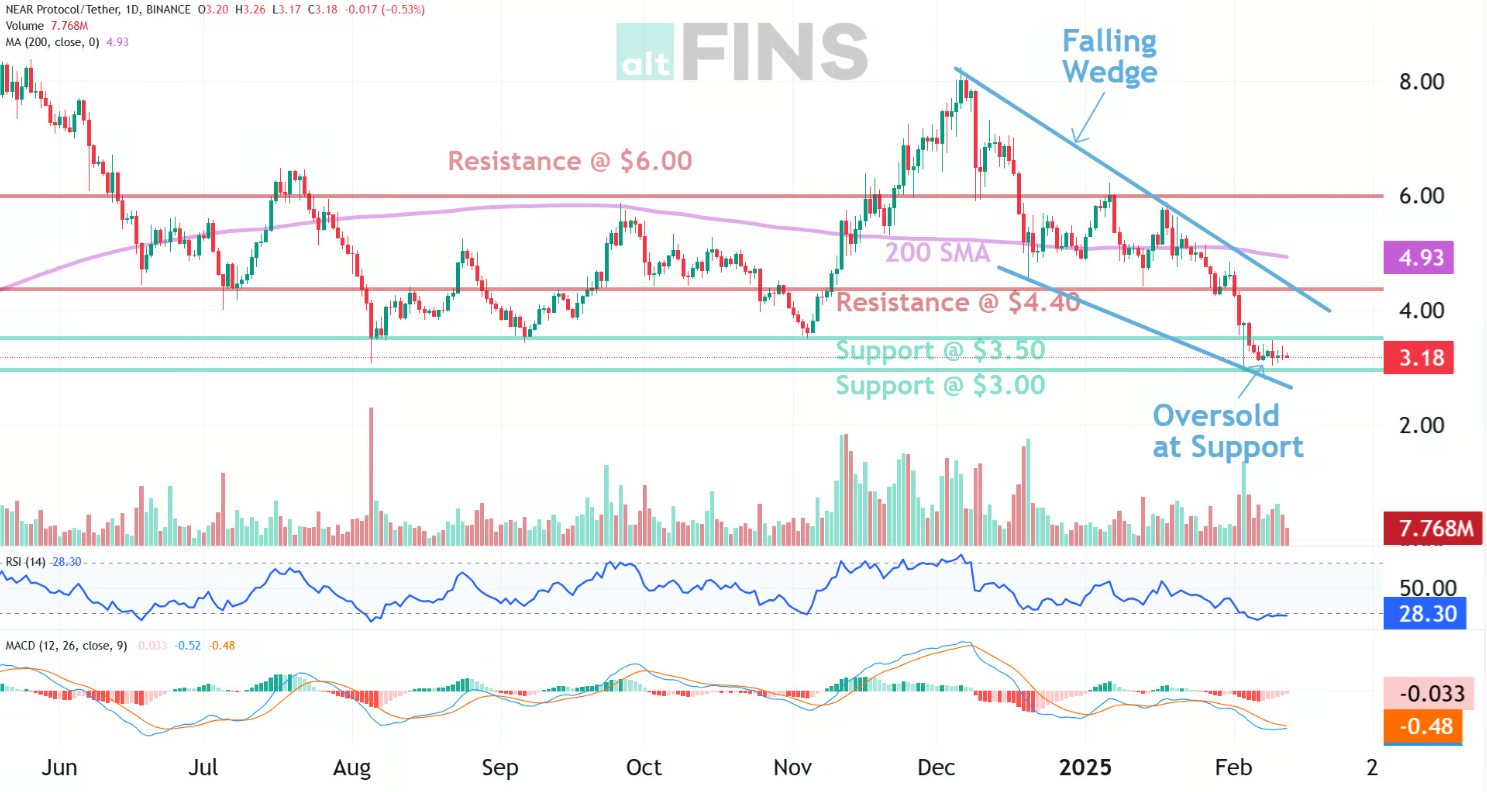NEAR Protocol (NEAR) Analysis
In addition to automated chart patterns, altFINS’ analysts conduct technical chart analyses of top 30 cryptocurrencies. We call these Curated Charts and they evaluate 5 core principals of technical analysis: Trend, Momentum, Patterns, Volume, Support and Resistance.
NEAR Protocol (NEAR) technical analysis:
Trade setup: Price broke below 200-day moving average (200 SMA) which signals onset of Downtrend. However, price has reached $3.00 support and is oversold (RSI < 30), hence, it could bounce up briefly near-term. (set a price alert). Learn to trade breakouts in Lesson 7 and Risk Management in Lesson 9.
Pattern: Price is Oversold at Support. This trading strategy finds assets that are oversold (RSI < 30) and are near a support area, which means there’s a high probability that price will bounce up near-term. Oversold conditions are typically reached when RSI hits 30 or less. Learn this trading strategy in Lesson 5.
Trend: Short-term trend is Strong Down, Medium-term trend is Strong Down, Long-term trend is Strong Down.
Momentum is Bearish but inflecting. MACD Line is still below MACD Signal Line but momentum may have bottomed since MACD Histogram bars are rising, which suggests that momentum could be nearing an upswing. Price is neither overbought nor oversold currently, based on RSI-14 levels (RSI > 30 and RSI < 70).
Support and Resistance: Nearest Support Zone is $3.00.
Nearest Resistance Zone is $4.40, then $6.00.

See live NEAR Protocol (NEAR) chart here
See more curated charts of coins with technical analyses.
Recent news and research:
NEAR partners with BitGo as it enters world of institutional investments
Trading giant Jane Street backs NEAR-based lending protocol in new funding round
(Jan 14.2022) NEAR raises $150 million as it looks to become a hub of web3 development
What Is NEAR Protocol? The Sharded Layer 1 Blockchain Explained
NEAR Chooses DODO as its Preferred DEX, Plans $7.5M Incentives with Funding from Proximity Labs
Find more real-time news here.
What is NEAR Protocol (NEAR)?
Find full description and news on altFINS platform.
IntroductionNEAR Protocol is a decentralized development platform designed for building and deploying decentralized applications (dApps). It employs a Proof-of-Stake (PoS) consensus mechanism and is designed to incorporate a sharded architecture to scale transaction throughput. NEAR’s block generation mechanism is called Doomslug, and its sharding design is known as Nightshade. Together, these technologies aim to increase network scalability and reduce congestion. The protocol is built with developer and user-friendliness in mind, offering key innovations for efficient application development and user onboarding. NEAR Protocol is developed by the NEAR Foundation, with its mainnet launched in April 2020 and token transfers enabled following a community vote in October 2020. The Rainbow Bridge, NEAR’s bridge to Ethereum, was introduced in March 2021.
Background and History
NEAR began as a machine learning research project before evolving into a blockchain platform. It was founded by Illia Polosukhin and Alexander Skidanov, who started NEAR.ai in 2017 to explore program synthesis. Their work in automating programs led them to investigate blockchain solutions for smart contracts and payments. Finding existing platforms inadequate for their needs, they began developing the NEAR Protocol in August 2018. The protocol launched its mainnet in April 2020, transitioned to community governance in September 2020, and enabled token transfers in October 2020.
Key Technologies and Innovations
Nightshade (Sharding Mechanism): NEAR employs a unique sharding technique called Nightshade, where individual shards produce data “chunks” that collectively form a single block. This approach improves transaction throughput and cross-shard communication. The leader-based system assigns one validator per block to aggregate chunks into blocks.
Doomslug (Block Production): Doomslug is NEAR’s novel block production mechanism that allows the network to achieve practical finality after one round of communication and BFT finality after a second round. This ensures fast and secure block production even if only half of the validators remain online.
Dynamic Re-sharding: NEAR utilizes dynamic re-sharding, adjusting the number of shards based on network demand. This enhances scalability and reduces costs by allocating resources efficiently.
Developer Incentives: NEAR distributes 30% of transaction fees to the developers of the smart contracts involved in those transactions. This incentivizes application development and network growth.
Token-Based Storage: NEAR uses a token-based storage model where users can store data proportional to their NEAR token holdings. This system ensures validators are compensated for storing on-chain data.
Governance
NEAR’s governance is community-driven. Proposals for protocol improvements are submitted and discussed on the NEAR forum. Validators have the final say by choosing to adopt updates through client releases. Proposals can range from routine improvements to urgent hotfixes, with community input playing a crucial role in shaping the network’s evolution.
NEAR Token Usage
- Security: NEAR tokens are staked to secure the network, with validators earning rewards for their contributions. The PoS model also provides protection against DDoS attacks.
- Transaction Fees: The network charges fees for processing transactions, with a portion burned to control token supply and another portion allocated to developers as rewards.
- Developer Rewards: A minimum percentage of transaction fees generated by smart contract usage is allocated to the contract’s developers, incentivizing early development and increasing network activity.
- Storage: NEAR token holders can store data on the blockchain, with storage capacity linked to their token balance.
Conclusion
NEAR Protocol combines advanced technologies like Nightshade and Doomslug to provide a scalable, efficient, and user-friendly blockchain platform. Its developer incentives and community-driven governance make it a compelling choice for building decentralized applications. As NEAR continues to evolve, it aims to support mass adoption of decentralized solutions through performance, accessibility, and innovation.